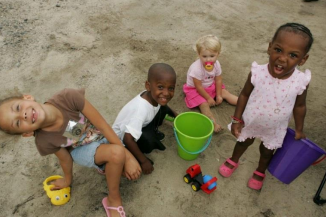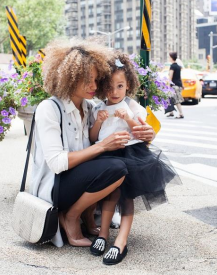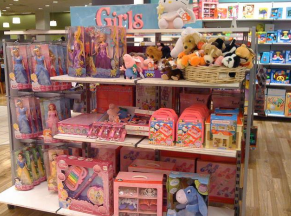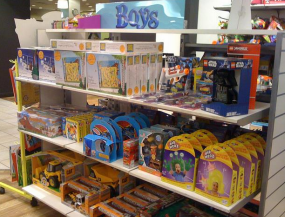12 Emotional Development in the Preschool Years
Chapter Objectives
After this chapter, you should be able to:
- Describe the continuum of development of emotional skills in preschoolers.
- Describe how preschoolers view themselves.
- Summarize Erikson’s stage of initiative versus guilt.
- Explain how children develop their understanding of gender.
- Discuss personality and temperament.
- Identify the effects of stress on three- to five-year olds.
INTRODUCTION
In the preschool years, children’s understanding of themselves continues to evolve. Let’s examine some of the important interactions in emotional development between the ages of 2.5 and 6 years.
Continuum of Development
The Continuum of Development set out in Early Learning for Every Child Today: A framework for Ontario early childhood settings (2007) identifies several root emotional skills that are emerging in children between 2.5 and 6 years of age (Ministry of Education, 2014).
The preschooler is starting to solidify their self-concept, identity and self-esteem. They have improved their ability to recognize and express their emotions appropriately. A typically developing preschooler is developing the ability to regulate their attention, emotions and behavior. These emerging competencies help them persevere when faced with challenges and cope when unsuccessful at a task.
Interactionism and Views of Self
Early childhood is a time of forming an initial sense of self. A self-concept or idea of who we are, what we are capable of doing, and how we think and feel is a social process that involves taking into consideration how others view us. So, in order to develop a sense of self, you must have interaction with others. Interactionist theorists, Cooley and Mead offer two interesting explanations of how a sense of self develops.
Cooley
Charles Horton Cooley (1964, as cited by Paris, Ricardo, Raymond, & Johnson, 2021) suggests that our self-concept comes from looking at how others respond to us. This process, known as the looking-glass self involves looking at how others seem to view us and interpreting this as we make judgments about whether we are good or bad, strong or weak, beautiful or ugly, and so on. Of course, we do not always interpret their responses accurately so our self-concept is not simply a mirror reflection of the views of others. After forming an initial self-concept, we may use it as a mental filter screening out those responses that do not seem to fit our ideas of who we are. Some compliments may be negated, for example. The process of the looking-glass self is pronounced when we are preschoolers, or perhaps when we are in a new school or job or are taking on a new role in our personal lives and are trying to gauge our own performances. When we feel more sure of who we are, we focus less on how we appear to others (Leon, n.d.).

Figure 12.1: A child looking at herself wearing glasses in a mirror. (Image is in the public domain)
Mead
Herbert Mead (1967, as cited by Paris, Ricardo, Raymond, & Johnson, 2021) offers an explanation of how we develop a social sense of self by being able to see ourselves through the eyes of others. There are two parts of the self: the “I” which is the part of the self that is spontaneous, creative, innate, and is not concerned with how others view us and the “me” or the social definition of who we are.
When we are born, we are all “I” and act without concern about how others view us. But the socialized self begins when we are able to consider how one important person views us. This initial stage is called “taking the role of the significant other”. For example, a child may pull a cat’s tail and be told by their mother, “No! Don’t do that, that’s bad” while receiving a slight slap on the hand. Later, the child may mimic the same behavior toward the self and say aloud, “No, that’s bad” while patting his own hand. What has happened? The child is able to see themself through the eyes of the mother. As the child grows and is exposed to many situations and rules of culture, he begins to view the self in the eyes of many others through these cultural norms or rules. This is referred to as “taking the role of the generalized other” and results in a sense of self with many dimensions. The child comes to have a sense of self as a student, as a friend, as a child, and so on.
Exaggerated Sense of Self
One of the ways to gain a clearer sense of self is to exaggerate those qualities that are to be incorporated into the self. Preschoolers often like to exaggerate their own qualities or to seek validation as the biggest, smartest, or child who can jump the highest. This exaggeration tends to be replaced by a more realistic sense of self in middle childhood.
Self-Esteem
Early childhood is a time of forming an initial sense of self. Self-concept is our self-description according to various categories, such as our external and internal qualities. In contrast, self-esteem is an evaluative judgment about who we are. The emergence of cognitive skills in this age group results in improved perceptions of the self, but they tend to focus on external qualities, which are referred to as the categorical self. When researchers ask young children to describe themselves, their descriptions tend to include physical descriptors, preferred activities, and favorite possessions. Thus, the self-description of a 3-year-old might be a 3-year-old girl with red hair, who likes to play with blocks. However, even children as young as three know there is more to themselves than these external characteristics.
Harter and Pike (1984, as cited by Paris, Ricardo, Raymond, & Johnson, 2021) challenged the method of measuring personality with an open-ended question as they felt that language limitations were hindering the ability of young children to express their self-knowledge. They suggested a change to the method of measuring self-concept in young children, whereby researchers provide statements that ask whether something is true of the child (e.g., “I like to boss people around”, “I am grumpy most of the time”). They discovered that in early childhood, children answer these statements in an internally consistent manner, especially after the age of four (Goodvin, Meyer, Thompson & Hayes, 2008, as cited by Paris, Ricardo, Raymond, & Johnson, 2021) and often give similar responses to what others (parents and teachers) say about the child (Brown, Mangelsdorf, Agathen, & Ho, 2008; Colwell & Lindsey, 2003, as cited by Paris, Ricardo, Raymond, & Johnson, 2021).

Figure 12.2: Young children tend to feel good about themselves. (Photo by Lukas Rychvalsky on Unsplash)
Young children tend to have a generally positive self-image. This optimism is often the result of a lack of social comparison when making self-evaluations (Ruble, Boggiano, Feldman, & Loeble, 1980, as cited by Paris, Ricardo, Raymond, & Johnson, 2021), and with comparison between what the child once could do to what they can do now (Kemple, 1995). However, this does not mean that preschool children are exempt from negative self-evaluations. Preschool children with insecure attachments to their caregivers tend to have lower self-esteem at age four (Goodvin et al., 2008, as cited by Paris, Ricardo, Raymond, & Johnson, 2021). Maternal negative affect (emotional state) was also found by Goodwin and her colleagues to produce more negative self-evaluations in preschool children.
Self-Control
Self-control is not a single phenomenon but is multi-faceted. It includes response initiation, the ability to not initiate a behavior before you have evaluated all of the information, response inhibition, the ability to stop a behavior that has already begun, and delayed gratification, the ability to hold out for a larger reward by forgoing a smaller immediate reward (Dougherty, Marsh, Mathias, & Swann, 2005). It is in early childhood that we see the start of self-control, a process that takes many years to fully develop. In the famous “Marshmallow Test” (Mischel, Ebbesen, & Zeiss, 1972, as cited by Paris, Ricardo, Raymond, & Johnson, 2021) children aged 3-5 years are confronted with the choice of a small immediate reward (a marshmallow) and a larger delayed reward (more marshmallows). Children who were able to distract themselves from thinking about how much they wanted the delayed reward were more likely to be able to wait for the reward. In follow-up research, Walter Mischel and colleagues over the years have found that the ability to delay gratification at the age of four predicted better academic performance and health later in life (Mischel, et al., 2011, as cited by Paris, Ricardo, Raymond, & Johnson, 2021). Self-control is related to executive function; as executive function improves, children become less impulsive (Traverso, Viterbori, & Usai, 2015, as cited by Paris, Ricardo, Raymond, & Johnson, 2021).
Attempts to replicate the findings of the original “Marshmallow Test” as well as Mischel’s follow-up research have been inconsistent. The “Marshmallow Test” has been criticized because of the small sample size (50 children) and because the children all came from wealthy families with well-educated parents.
Dr. Stuart Shanker believes that the “Marshmallow Test” is actually a stress test. He suggests that a lack of self-control is a symptom of stress. This view is consistent with other critics of the “Marshmallow Test” who believe the results should not be applied to less affluent populations. For example, a child who comes to school hungry because they live in a food-insecure family is experiencing physical stress that would make it very difficult to wait for a food reward instead of taking an immediate food reward. When we reduce stressors in a child’s life, their ability to control their own behaviour improves (Shanker’s concept of “self-regulation”).
Self-Control and Play
Thanks to the new Centre for Research on Play in Education, Development and Learning (PEDaL), Whitebread, Baker, Gibson and a team of researchers hope to provide evidence on the role played by play in how a child develops, as cited in Paris, Ricardo, Raymond, & Johnson, 2021.
“A strong possibility is that play supports the early development of children’s self-control,” explains Baker. “These are our abilities to develop awareness of our own thinking processes – they influence how effectively we go about undertaking challenging activities.”
A study carried out by Baker with toddlers and young preschoolers found that children with greater self-control solved problems quicker when exploring an unfamiliar set-up requiring scientific reasoning, regardless of their IQ.” This sort of evidence makes us think that giving children the chance to play will make them more successful and creative problem-solvers in the long run.”
If playful experiences do facilitate this aspect of development, say the researchers, it could be extremely significant for educational practices because the ability to self-regulate has been shown to be a key predictor of academic performance.
Gibson adds: “Playful behavior is also an important indicator of healthy social and emotional development. In my previous research, I investigated how observing children at play can give us important clues about their well being and can even be useful in the diagnosis of neuro-developmental disorders like autism” (Play’s the Thing, by the University of Cambridge is licensed under CC BY 4.0).
Moral Development
Dr. Charles A. Smith, in the paper “Beyond ‘I’m Sorry”: The Emergence of Conscience in Young Children” defines conscience as “an internal voice that obliges us to act with kindness, respect, and fairness and to make things right as best we can when we do not” (Smith, n.d.). Brain development during the first three years of life enables the preschool-aged child to begin to understand the difference between right and wrong. Emerging skills of self-control, compassion, sympathy and empathy also contribute to the development of a conscience. Parents, teachers and peers all play a role in helping children learn to care about themselves and others.
Preschoolers are beginning to be able to understand the difference between moral rules and social conventions. Moral rules are non-negotiable; for example, it is wrong to steal or murder. Social conventions are more arbitrary rules that a group has agreed upon; for example, standing in a line to board a bus. It is typical for children to test the limits of social conventions to learn what behavior is allowed and what will not be allowed. How adults respond to testing of limits is important. Dr. Smith believes “Preschool children do not fully understand the responsibility for repairing a wrong. Being forced to say, “I’m sorry” can become a magic incantation of absolution, as though words alone are enough to free them from the consequences of their choices” (Smith, n.d.). Children learn to truly care about others through their own relationships with caring adults.
Erikson – Initiative Vs Guilt
Psychologist Erik Erikson argues that children in early childhood go through a stage of “initiative vs. guilt”. If the child is placed in an environment where they can explore, make decisions, and initiate activities, they have achieved initiative. On the other hand, if the child is put in an environment where initiation is repressed through criticism and control, they will develop a sense of guilt.

Figure 12.3: Children playing in the sand. (Image is in the public domain from Wikimedia Commons)
The trust and autonomy of previous stages develop into a desire to take initiative or to think of ideas and initiative action. Children may want to build a fort with the cushions from the living room couch or open a lemonade stand in the driveway or make a zoo with their stuffed animals and issue tickets to those who want to come. Or they may just want to get themselves ready for bed without any assistance. To reinforce taking initiative, caregivers should offer praise for the child’s efforts and avoid being critical of messes or mistakes. Soggy washrags and toothpaste left in the sink pales in comparison to the smiling face of a five-year-old that emerges from the bathroom with clean teeth and pajamas! (Leon, n.d.).
Gender Identity, Gender Constancy, and Gender Roles
Another important dimension of the self is the sense of self as male or female. Preschool-aged children become increasingly interested in finding out the differences between boys and girls both physically and in terms of what activities are acceptable for each. While 2-year-olds can identify some differences and learn whether they are boys or girls, preschoolers become more interested in what it means to be male or female. This self-identification or gender identity is followed sometime later with gender constancy or the knowledge that gender does not change. Gender roles or the rights and expectations that are associated with being male or female are learned throughout childhood and into adulthood.
Freud and the Phallic Stage
Freud believed that masculinity and femininity were learned during the phallic stage of psychosexual development. According to Freud, during the phallic stage, the child develops an attraction to the opposite-sex parent but after recognizing that they cannot actually be romantically involved with that parent, the child learns to model their own behaviour after the same-sex parent. The child develops their own sense of masculinity or femininity from this resolution. And, according to Freud, a person who does not exhibit gender-appropriate behaviour, such as a woman who competes with men for jobs or a man who lacks self-assurance and dominance, has not successfully completed this stage of development. Consequently, such a person continues to struggle with their own gender identity.
Chodorow and Mothering
Chodorow, a Neo-Freudian, believed that mothering promotes gender stereotypic behaviour. Mothers push their sons away too soon and direct their attention toward problem-solving and independence. As a result, sons grow up confident in their own abilities but uncomfortable with intimacy. Girls are kept dependent too long and are given unnecessary and even unwelcome assistance from their mothers. Girls learn to underestimate their abilities and lack assertiveness but feel comfortable with intimacy.

Figure 12.4: A boy showing independence and confidence. (Image by Adam Jones is licensed under CC BY-SA 2.0)

Figure 12.5: A girl showing dependence and comfort within a relationship. (Image by Free-Photos on Pixabay)
Both of these models assume that early childhood experiences result in lifelong gender self-concepts. However, current thinking refutes this assumption and sees gender socialization as a process of refinement and modification that continues throughout life.
Learning through Reinforcement and Modelling
Learning theorists suggest that gender role socialization is a result of the ways in which parents, extended family, teachers, friends, schools, religious institutions, media and others send messages about what is acceptable or desirable behaviour as males or females. This socialization begins early-in fact, it may even begin the moment a parent learns that a child is on the way. Knowing the sex of the child can conjure up images of the child’s behaviour, appearance, and potential on the part of some parents. And this stereotyping may continue to guide perception through life. Consider parents of newborns, shown a 7 pound, 20 inch baby, wrapped in blue (a colour associated with males in Western cultures) describe the child as tough, strong, and angry when crying. Shown the same infant in pink (a colour associated with baby girls in Western cultures), these parents are likely to describe the baby as pretty, delicate, and frustrated when crying. (Maccoby & Jacklin, 1987, as cited by Paris, Ricardo, Raymond, & Johnson, 2021). In Western cultures, female infants may be held more, talked to more frequently and given direct eye contact, while male infants play is often mediated through a toy or activity.
Parents who hold traditional views of male and females gender roles are more likely to give sons tasks that take them outside the house and that have to be performed only on occasion while girls are more likely to be given chores inside the home such as cleaning or cooking that is performed daily. These parents may also encourage sons to think for themselves when they encounter problems while daughters are more likely to be given assistance even when they are working on an answer. This impatience is reflected in teachers waiting less time when asking a female student for an answer than when asking for a reply from a male student (Sadker and Sadker, 1994, as cited by Paris, Ricardo, Raymond, & Johnson, 2021). Girls are given the message from teachers that they must try harder and endure in order to succeed while boys’ successes are attributed to their intelligence. Cultural gender role stereotypes can also influence which kinds of courses or vocational choices girls and boys are encouraged to make.
Friends discuss what is acceptable for boys and girls and popularity may be based on modelling what is considered ideal behaviour or looks for the sexes. Girls tend to tell one another secrets to validate others as best friends while boys compete for position by emphasizing their knowledge, strength or accomplishments. This focus on accomplishments can even give rise to exaggerating accomplishments in boys, but girls are discouraged from showing off and may learn to minimize their accomplishments as a result.
Gender messages abound in our environment. The Western stereotypes that boys should be strong, forceful, active, dominant, and rational and that girls should be pretty, subordinate, unintelligent, emotional, and gabby are portrayed in children’s toys, books, commercials, video games, movies, television shows and music.
Some School Boards in Ontario have developed policies and best practices concerning gender identity and gender expression. For example, the Ottawa-Carleton District School Board’s document “Gender Identity and Gender Expression: Guide to Support Our Students” expects its educators to challenge gender stereotypes. Specific actions include:
- Letting all students engage in an activity, not limit the number of boys or girls in a group.
- Encouraging students to take on various roles in a group.
- Avoiding separating boys and girls for activities (e.g. boys go to the gym and girls go to the library)
Avoiding giving out awards based on gender (e.g. Most books read by a boy in a month versus most books read by a girl in a month) - Intervening when children use gender-specific words to make fun of each other (Ottawa Carleton District School Board, 2021). But does this mean that each of us receives and interprets these messages in the same way? Probably not. In addition to being recipients of Western cultural expectations, we are individuals who also modify these roles (Kimmel, 2008, as cited in Paris, Ricardo, Raymond, & Johnson, 2021). Based on what young children learn about gender from parents, peers, media and those who they observe and interact with in society, children develop their own conceptions of the attributes associated with maleness or femaleness which is referred to as gender schemas.

Figure 12.6: Store shelves filled with pink and purple colors and girls’ toys. (Image by Janet McKnight is licensed under CC BY 2.0)

Figure 12.7: Store shelves filled with primary colours and boys’ toys. (Image by Janet McKnight is licensed under CC BY 2.0)
Indigenous Perspectives
Gender messages are seen in our ceremonies. Boy’s and girl’s responsibilities are taught as early as 1 year old during the Walking Out ceremony (this ceremony only pertains to the Anishinabe people). These are not seen as stereotypical but rather what Creator is asking of us. For instance, a boy is taught that he is the protector and the hunter with the responsibility of the fire during ceremony in patriarchal societies. As for the girl, they are responsible for cooking, rearing the children, showing the children what is expected of them and protecting the water in life and in ceremony. Both genders are taught to be strong, active, rational, and respectful of the other gender including Two Spirit people. The girls are not taught that they are subordinate, unintelligent or just a pretty thing. Today it is not uncommon to see young girls taught to hunt, trap or fish or young men to take care of the children. There is more a sense of community and of respect towards all genders. The women are highly respected as the life givers and the men are highly regarded as the hunters and protectors. It is only because of colonization that these concepts started changing. Men started disrespecting and abusing women because of the Western ideologies. Men had lost their way which resulted in the women having to take over the roles and responsibilities of men. This is slowly starting to change due to the return of our cultural and traditional teachings.
Gender identity is not something that is/was important to First Nation communities but rather for the gifts that individual brought to the greater community. The term Two Spirit is a pan Indian term that was created in 1990s by non-Indigenous people. In many teachings, individuals who fall under LGBTQ are regarded as two spirited. Two Spirit individuals are wanting to reclaim the pre-colonial teachings.
“Historically, each nation had their own terms and concepts for Two Spirit people. The roles of the Two Spirit people were teachers, caregivers, medicine people and helpers. They were highly respected for their understanding of both man and woman. They were also seen as having special spiritual gifts.” from the following source; Supporting the Sacred Journey. There is also a well-respected knowledge keeper called Albert McLeod who has worked tirelessly for the rights of Two-Spirit.
Gender Dysphoria
A growing body of research is now focused on Gender Dysphoria, or the distress accompanying a mismatch between one’s gender identity and biological sex (American Psychiatric Association, 2013, as cited by Paris, Ricardo, Raymond, & Johnson, 2021). The 2018 Survey of Safety in Public and Private Spaces estimated that 0.24% of Canadians aged 15 or older identified as transgender (Statistics Canada, 2020). Sexual minority people are almost three times more likely to experience violent victimization than heterosexual people (Statistics Canada, 2020). Comments such as stating they prefer the toys, clothing and anatomy of the opposite sex, while rejecting the toys, clothing, and anatomy of their assigned sex are criteria for a diagnosis of Gender Dysphoria in children. Certainly, many young children do not conform to the gender roles modeled by the culture and even push back against assigned roles. However, they do not experience discomfort regarding their gender identity and would not be identified with Gender Dysphoria.
Personality
Parents often scrutinize their child’s preferences, characteristics, and responses for clues of a developing personality. They are quite right to do so because temperament is a foundation for personality growth. But temperament (defined as early-emerging differences in reactivity and self-regulation) is not the whole story. Although temperament is biologically based, it interacts with the influence of experience from the moment of birth (if not before) to shape personality (Rothbart, 2011, as cited in Paris, Ricardo, Raymond, & Johnson, 2021). Temperamental dispositions are affected, for example, by the support level of parental care. More generally, personality is shaped by the goodness of fit between the child’s temperamental qualities and characteristics of the environment (Chess & Thomas, 1999, as cited in Paris, Ricardo, Raymond, & Johnson, 2021). For example, an adventurous child whose parents regularly take them on weekend hiking and fishing trips would be a good “fit” for their lifestyle, supporting personality growth. Personality is the result, therefore, of the continuous interplay between biological disposition and experience, as is true for many other aspects of social and personality development.
Personality develops from temperament in other ways (Thompson, Winer, & Goodvin, 2010, as cited in Paris, Ricardo, Raymond, & Johnson, 2021). As children mature biologically, temperamental characteristics emerge and change over time. A newborn is not capable of much self-control, but as brain-based capacities for self-control advance, temperamental changes in self-regulation become more apparent. So an infant that cries frequently doesn’t necessarily have a grumpy personality. With sufficient parental support and increased sense of security, the child may develop into a content preschooler that is not likely to cry to get her needs met.

Figure 12.8: A girl enjoying nature. (Image by Khanh Steven on Unsplash)
In addition, personality is made up of many other features besides temperament. Children’s developing self-concept, their motivations to achieve or to socialize, their values and goals, their coping styles, their sense of responsibility and conscientiousness, and many other qualities are encompassed into personality. These qualities are influenced by biological dispositions, but even more by the child’s experiences with others, particularly in close relationships, that guide the growth of individual characteristics. Indeed, personality development begins with the biological foundations of temperament but becomes increasingly elaborated, extended, and refined over time. The newborn that parents observed in wonder upon becomes an adult with a personality of depth and nuance.
Childhood Stress and Development
Canadian researcher and author, Dr. Stuart Shanker (1952- ), is a leading expert on how stress impacts children and their development. He believes that many developmental and behavioural challenges in children are caused by an overactive stress response. Typical behaviours seen in children under stress include poor attention, emotion regulation, and self-control. These are the “symptoms”. Like a fever is a symptom of an infection that won’t go away until the infection is cured, the behavioural symptoms of stress can’t be alleviated until the cause is addressed – reducing the child’s stress.
What is the impact of stress on child development? Children experience different types of stressors. Normal, everyday stress can provide an opportunity for young children to build coping skills and poses little risk to development. Even more long-lasting stressful events such as changing schools or losing a loved one can be managed fairly well. But children who experience toxic stress or who live in extremely stressful situations of abuse over long periods of time can suffer long-lasting effects. The structures in the midbrain or limbic system such as the hippocampus and amygdala can be vulnerable to prolonged stress during early childhood (Middlebrooks and Audage, 2008, as cited in Paris, Ricardo, Raymond, & Johnson, 2021). High levels of the stress hormone cortisol can reduce the size of the hippocampus and affect the child’s memory abilities. Stress hormones can also reduce immunity to disease. The brain exposed to long periods of severe stress can develop a low threshold making the child hypersensitive to stress in the future. However, the effects of stress can be minimized if the child has the support of caring adults. Let’s take a look at childhood stressors.
Effects of Domestic Abuse
In 2015, about 10% of Canadians stated that, as a child, they had witnessed domestic violence (Statistics Canada, 2015). There has been an increase in acknowledgment that children exposed to domestic abuse during their upbringing will suffer in their developmental and psychological welfare. Because of the awareness of domestic violence that some children have to face, it also generally impacts how the child develops emotionally, socially, behaviourally as well as cognitively. Some emotional and behavioral problems that can result due to domestic violence include increased aggressiveness, anxiety, and changes in how a child socializes with friends, family, and authorities. Bruises, broken bones, head injuries, lacerations, and internal bleeding are some of the acute effects of a domestic violence incident that require medical attention and hospitalization.
Child Maltreatment
Child abuse is the physical, sexual, or emotional mistreatment or neglect of a child or children. Most Canadian jurisdictions have added exposure to family violence as a distinct form of maltreatment in addition to physical abuse, sexual abuse, neglect and emotional harm. Accurate statistics about the rate of incidence of child maltreatment are difficult to obtain because of under-reporting.
Child Maltreatment in Canada
“Findings from an Ontario community-based survey indicate that maltreatment is a common experience for children living in that province. A history of experiencing physical abuse during childhood was reported by 31.2% of males and 21.1% of females, with similar proportions of males (10.7%) and females (9.2%) reporting a history of severe physical abuse. More females (12.8%) than males (4.3%) reported experiences of childhood sexual abuse. Overall, 33% of males and 27% of females reported that they had experienced one or more incidents of physical and/or sexual abuse during their childhood.
Given that this Ontario survey did not ask questions about neglect, emotional harm or exposure to family violence, the overall message it suggests is that at least one in three individuals experiences some form of maltreatment over the course of their childhood. It seems safe to say that if all five types of child maltreatment were taken into consideration, this proportion would be much higher” (Government of Canada, 2012).
Physical Abuse
Physical abuse occurs when a person in a position of trust or authority purposefully injures or threatens to injure a child or youth. Examples of physical abuse include but are not limited to: shaking, hitting, excessively pinching, slapping or tripping a child, withholding sleep, food or medication, burning or scalding.
The distinction between physical abuse and discipline is not well understood. In Canada, Section 43 of the Criminal Code of Canada allows the use of some physical force by a parent (or person standing in for a parent) if the purpose is to discipline a child. However, the force must be “reasonable” under the circumstances. In 2004, the Supreme Court of Canada narrowed the definition of “reasonable” to mean “ transitory and trifling” (Government of Canada, 2021). Any action that leaves a mark on a child, such as a bruise, would not be considered reasonable. The Supreme Court also issued the following guidelines:
- Physical punishment cannot be used on children younger than 2 years or older than 12 years.
- Objects such as belts or rulers cannot be used on a child.
- A child is never to be hit on the face or head.
- Any use of force cannot be degrading.
- Physical punishment cannot be used on a child who is not able to understand the situation because of a developmental delay (Government of Canada, 2021).
Spanking as a form of physical punishment could be considered legal under the Criminal Code of Canada if the Supreme Court’s guidelines are followed. However, this does not prevent provincial/territorial/Indigenous child protection agencies from considering spanking as grounds for protection.
Sexual Abuse
Child sexual abuse is a form of child abuse in which an adult or older adolescent abuses a child for sexual stimulation. Effects of child sexual abuse include guilt and self-blame, flashbacks, nightmares, insomnia, and fear of things associated with the abuse. In 2014, Statistics Canada conducted a survey of 33,000 individuals over the age of 15. 8% of respondents reported childhood sexual abuse. This would correspond to approximately 2.4 million Canadians. This is probably an under-representation of the true number, as it only captured respondents willing to self-disclose to an unknown person on a phone (Canadian Centre for Child Protection, 2018).
Emotional Abuse
Out of all the possible forms of abuse, emotional abuse is the hardest to define. It could include name-calling, ridicule, degradation, destruction of personal belongings, torture or killing of a pet, excessive criticism, inappropriate or excessive demands, withholding communication, and routine labeling or humiliation.
Neglect
Neglect is a passive form of abuse in which a perpetrator is responsible to provide care for a victim who is unable to care for themselves but fails to provide adequate care. Neglect may include the failure to provide sufficient supervision, nourishment, or medical care, or the failure to fulfill other needs for which the victim is helpless to provide for themselves. Neglect can have many long-term side effects, such as physical injuries, low self-esteem, attention disorders, violent behaviour, and even death.
Child Protection Legislation in Canada
In Canada, child protection falls under the jurisdiction of the provinces, territories and Indigenous welfare agencies. Legislation varies across these different jurisdictions.
In Ontario, The Child Youth and Family Services Act, offers protection to children under the age of 18. In relationship to types of abuse, under this legislation a child is in need of protection when there is:
- Physical harm or a likely risk of physical harm
- A pattern of neglect
- Sexual abuse or exploitation or a likely risk of sexual abuse or exploitation
- Emotional harm or a likely risk of emotional harm
- Failure to agree to treatment to relieve physical harm, sexual abuse or neglect (Province of Ontario, 2017).
In Canada, some Indigenous communities manage their own child welfare services, ensuring culturally appropriate programs and services. However, not all communities, especially un-ceded communities or those not recognized by the government, fall under provincial child protection legislation. Some communities, including the Metis people, are still fighting to be included in child protection legislation. In Ontario, there are 11 Indigenous children’s aid societies. The importance of self-governance in relationship to child welfare was a key finding of the Truth and Reconciliation Commission of Canada, 2015. (National Collaborating Centre for Aboriginal Health, 2017).
Summary
References
Canadian Centre for Child Protection. (2018). Child sexual abuse by K-12 personnel in Canada: Executive summary. Retrieved from https://www.protectchildren.ca/pdfs/C3P_CSAinSchoolsReport_en.pdf
Driskill, Q., Finley, C., Gilley, B. J., & Morgensen, S. L. (2011). Queer Indigenous studies: Critical interventions in theory, politics, and literature. Tucson, AZ: University of Arizona Press.
Government of Canada. (2021). Criminal law and managing children’s behaviour. Retrieved from https://www.justice.gc.ca/eng/rp-pr/cj-jp/fv-vf/mcb-cce/index.html
Government of Canada. (2012). Child maltreatment in Canada. Retrieved from https://www.canada.ca/en/public-health/services/health-promotion/stop-family-violence/prevention-resource-centre/children/child-maltreatment-canada.html
Leon, A. (n.d.). Children’s development: Prenatal through adolescent development. Retrieved from https://docs.google.com/document/d/1k1xtrXy6j9_NAqZdGv8nBn_I6-lDtEgEFf7skHjvE-Y/edit
National Collaborating Centre for Aboriginal Health. (2017). Indigenous children and the child welfare system in Canada. Retrieved from https://www.nccih.ca/docs/health/FS-ChildWelfareCanada-EN.pdf
Ontario Ministry of Education. (2014). Excerpts from “ELECT”. Retrieved from https://countrycasa.ca/images/ExcerptsFromELECT.pdf
Ottawa Carleton District School Board. (2021). Gender identity and gender expression: Fostering inclusive learning environments for all students. Retrieved from https://p13cdn4static.sharpschool.com/UserFiles/Servers/Server_55394/File/Our%20Schools/Indigenous,%20Equity%20and%20Human%20Rights/2SLGBTQ/Gender%20Identity%20and%20Gender%20Expression.pdf
Province of Ontario. (2017). Child, youth, and family services act: S.O. 2017, c. 14, Sched. 1. Retrieved from https://www.ontario.ca/laws/statute/17c14
Smith, C.A. (n.d.). Beyond “I’m sorry”:The emergence of conscience in young children. Retrieved from https://www.k-state.edu/wwparent/ethics/mod1/beyond_sorry.pdf
Statistics Canada. (2020). Sexual minority people almost three times more likely to experience violent victimization than heterosexual people. Retrieved from https://www150.statcan.gc.ca/n1/daily-quotidien/200909/dq200909a-eng.htm
Statistics Canada. (2017). Family violence in Canada: A statistical profile, 2015. Retrieved from https://www150.statcan.gc.ca/n1/daily-quotidien/170216/dq170216b-eng.htm
University of Cambridge. (n.d.). Play’s the thing. Retrieved from https://www.cam.ac.uk/research/features/plays-the-thing

